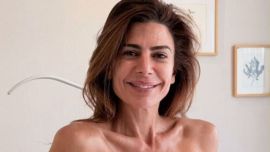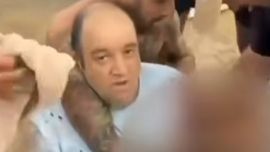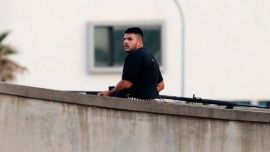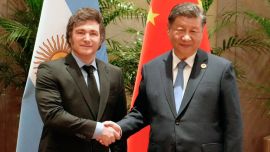Pope Francis' modest tomb drew large queues of faithful in Rome this week, days after an estimated 400,000 people turned out for his funeral and burial.
Tens of thousands flocked to Santa María Maggiore Basilica – the pontiff’s final resting place – in another testament to the popularity of the Argentine, who died aged 88 on April 21.
An energetic reformer who championed the poorest and most vulnerable, Francis is credited with reinvigorating the Catholic Church's appeal with his open, welcoming stance – a hard act to follow for whoever succeeds him.
All eyes turn now to the conclave, the secretive meeting of cardinals set to convene next week to elect a new pontiff.
"What I expect from his successor is that he continues [Francis'] work," Malian cardinal Jean Zerbo, 81, told journalists outside the basilica on Monday.
The Church needed to avoid divisions in picking a new leader, he said. "The message he left the world was one of openness, not closure. Welcoming everyone, especially the poorest."
‘Princes of the Church’
More than 180 "Princes of the Church" met behind closed doors this week to discuss what they want from the next leader of the world's 1.4 billion Catholics.
"There is a lot of dialogue," said Colombian Cardinal Jorge Enrique Jiménez Carvajal, 83, as he entered the Paul VI Hall at the Vatican for the talks. "The atmosphere is very peaceful."
After discussing issues such as child sex abuse in the Church and the institution's role in the modern world earlier in the week, talk turned midweek to the Vatican's finances.
The conclave begins on May 7, when a record 133 cardinals (those under the age of 80 who are eligible to vote) will enter the Sistine Chapel to vote in secret for a new pontiff. They will vote four times a day until two-thirds of them – at least 89 cardinals – agree on a single candidate.
Many cardinals have expressed hope for a short conclave, closer to the two days needed to elect both Francis and his predecessor Benedict XVI than the almost three years it took in the 13th century.
New face, new voices
With around 80 percent of cardinal electors having been appointed in the past 12 years by Francis, and hailing from all four corners of the globe, many of those voting have never met. At the meetings this week and last, "we are listening to people whom we have never listened to before... and that guides you," Cardinal Cristóbal López Romero, the Spanish-born Archbishop of Rabat, told AFP.
Francis, the first Latin American pope, opened the arms of the Catholic Church to the poor and marginalised. While that drew fervent devotion from many believers, his critics argued that he did not focus enough on key doctrines. The question now is whether his successor will follow in the same path, or forge a new one.
One European cardinal elector, who asked not to be named, said that what struck him was the diversity of the men called to choose a new pope.
"When the Africans or the South Americans speak, they are of different worlds. Not so much opposed, but we have a very Eurocentric view," he said. "We see that we do not have the same priorities."
Different character
But experts caution against assuming the cardinals will choose someone like Francis.
A former archbishop of Buenos Aires who loved being among his flock, Francis was a very different character to his predecessor Benedict XVI, a German theologian better suited to books than kissing babies.
Benedict in turn was a marked change from his Polish predecessor, the charismatic, athletic and hugely popular John Paul II.
Francis's changes triggered anger among many conservative Catholics, who hope the next pope will turn the focus back to doctrine.
Some cardinals have admitted the weight of the responsibility that faces them in choosing a new head of the world's 1.4 billion Catholics.
What we know ahead of the conclave
Dating back to the Middle Ages – when the idea of sovereigns being elected was somewhat revolutionary – the gathering, known as conclave, has an air of mystery about it, as all participants are sworn to secrecy for life.
Where and when
The conclave will begin on May 7 and last until a new pontiff is elected. The date was decided at a meeting of cardinals on Monday, where the high prelates also discussed the "qualities that the new pontiff must possess" and the most pressing Church challenges. These included "evangelisation, the relationship with other faiths [and] the issue of abuse", the Vatican said. While it took almost three years to appoint Pope Gregory X in the 13th century – the longest conclave to date – modern gatherings are usually a matter of days. Both Francis and his predecessor, Benedict XVI, were elected after two days of voting. Cardinals will gather and cast their ballots in the Sistine Chapel, a Renaissance jewel adorned with Michelangelo's celebrated frescoes, located in the Vatican City's Apostolic Palace.
Who takes part
Only 135 of the Church's 252 cardinals are expected to take part in the conclave, as only those aged under 80 are eligible to vote for a new pope. The gathering that decided on a date was attended by more than 180 cardinals, of which just over 100 were so-called "cardinal electors." Most of those allowed to vote were appointed by Francis – around 80 percent. They hail from all corners of the globe, with many from under-represented regions. But Europe still has the largest voting bloc, with 53 cardinals, compared to 27 cardinal-electors from Asia and Oceania, 21 from South and Central America, 16 from North America and 18 from Africa, according to the Vatican. Italy is the most represented nation with 17 electors. The United States has 10, Brazil seven and France five.
Secrecy and security
The word conclave comes from the Latin for "with key," a reference to the lockdown imposed on cardinals during the conclave. The deliberations of a conclave are held in strictest secrecy on pain of instant excommunication. Smartphones and any Internet access are off-limits and cardinals cannot read newspapers, listen to the radio or watch TV. The cardinals stay in the Santa Marta residence at the Vatican until they elect a new pope. Any contact with the outside world is banned, unless for "grave and urgent reasons," which need to be confirmed by a panel of four peers. Only cardinal electors are allowed to be present during the actual voting, although others including doctors, clerical assistants and housekeeping staff are allowed to enter at different times.
How voting unfolds
Cardinals hold four ballots a day – two in the morning and two in the afternoon – until one candidate wins two-thirds of the votes. At the end of each session, the ballots are burned in a special stove. With the addition of chemicals, the stove's chimney stack emits black smoke if no one has been elected, or white smoke if there is a new pope. If no new pope is elected after three days, cardinals take a break and hold a day of prayer and talks. Any single Catholic adult male can be elected pope, although in practice it is almost always one of the cardinals. Sick cardinals are allowed to cast their ballots from their beds within the Vatican.
What happens next
The winning candidate is asked by the Dean of Cardinals if he accepts the pontificate and, if the answer is yes, what name he chooses as pontiff. He then retreats to a room known as the Room of Tears to put on the papal garb – three sizes of which have been left there in advance – and emerge in front of the crowds in St Peter's Square. The new leader of the world's 1.4 billion Catholics then comes out onto a balcony overlooking the square as a senior cardinal cries: "Habemus Papam" ("We have a pope")!
– TIMES/AFP



















Comments